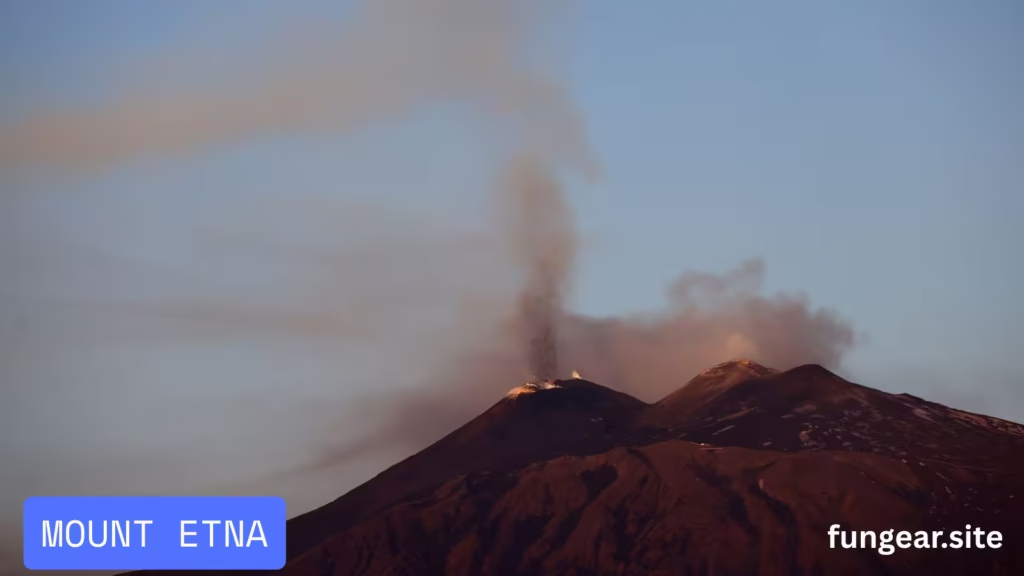Mount Etna has stirred again—and when Europe’s tallest and most active volcano speaks, the world listens.
Just after sunrise on a calm Monday morning, the Sicilian sky turned to smoke as Mount Etna erupted with a thunderous force, sending giant plumes of ash, gas, and volcanic debris miles into the atmosphere. Tourists who had been enjoying the scenic trails and panoramic views just hours earlier were now seen sprinting down slopes, pausing only to film the surreal moment before hurrying away from the looming threat.
While locals are no strangers to Etna’s temperamental nature, this eruption was far from routine. A mix of intense Strombolian explosions and a powerful pyroclastic flow made this outburst one of the most dramatic in recent years.

A Volcano That Never Sleeps
Etna is no stranger to drama. Sitting on the eastern edge of Sicily, the volcano towers over the Mediterranean like an ancient sentinel. It’s one of the most active volcanoes in the world, its periodic eruptions a fixture of island life—sometimes a background hum, sometimes a blaring alarm.
But even for seasoned geologists and lifelong residents, this week’s activity brought something different.
“It began in the early hours, around 00:39 local time,” Italy’s National Institute of Geophysics and Volcanology (INGV) reported. “We registered tremors—then explosions of increasing intensity.”
Those explosions quickly turned into a near-continuous stream of volcanic activity, with lava fountains, rockfalls, and plumes reaching over six kilometers (4 miles) high. INGV surveillance cameras captured the moment a portion of the southeastern crater collapsed—likely the trigger for the enormous pyroclastic flow that followed.
What Is a Pyroclastic Flow—and Why It’s So Dangerous
For those unfamiliar, a pyroclastic flow isn’t just smoke—it’s a deadly avalanche of ash, volcanic rock, and superheated gas. It moves fast, sometimes at speeds exceeding 100 km/h (62 mph), and it incinerates nearly everything in its path.
Fortunately, this flow did not breach the Valley of the Lions, a natural buffer zone between Etna’s summit and the lower tourist zones. As of now, no injuries or structural damage have been reported.
“The partial collapse of the south-east crater, which generated an impressive eruptive cloud and pyroclastic flow, is a phenomenon we are following with extreme caution,” said Renato Schifani, president of Sicily’s regional government.
The Sky Turns Red—and the Alerts Follow
As the eruption intensified, Italy’s Civil Protection Agency and aviation authorities issued a “code red” alert. Pilots were warned of the thick ash cloud spreading southwest, a direction that thankfully steered it away from densely populated areas.
At Catania airport—Sicily’s main aviation hub—operations remained mostly unaffected, although previous eruptions have grounded dozens of flights due to poor visibility and engine damage risks. Local officials confirmed that the airport remained open, but authorities were closely monitoring wind patterns and ash dispersal.
The Toulouse Volcanic Ash Advisory Centre backed the red alert, citing a “significant volume of ash in the atmosphere.”
Tourists Caught in the Moment
For many tourists, it started as a hike through one of Italy’s most iconic landmarks—and ended in a race against nature.
Videos posted across social media show visitors running, some barefoot, others in flip-flops, pausing only to snap photos or record footage as ash darkened the sky. One clip shows a group gasping as a thunderous explosion rips through the air behind them. “It was beautiful… and terrifying,” one traveler posted.
Others, perhaps drawn by adrenaline, lingered longer than advised. Local mountain rescuers later expressed concern over thrill-seekers taking selfies on unstable ground, calling the behavior “risky and reckless.”
Living With Etna
For Sicilians, Etna is both a neighbor and a mystery. She brings fertile soil to the surrounding vineyards and farms, even as she occasionally disrupts lives. There’s an almost mythological reverence for the mountain—locals call her “a muntagna,” the mountain.
But reverence doesn’t mean complacency.
Civil protection head Salvo Cocina issued a warning on Monday: “In consideration of the potential evolution of the phenomenon, tourists should avoid the summit area.” His message came amid increasing tremors and ongoing gas emissions that made the peak extremely dangerous.
Still, there was no official evacuation ordered. Most villages near the volcano were unaffected, thanks to Etna’s eruptive pattern favoring uninhabited upper slopes.
A Reminder of Nature’s Power
While this eruption is unlikely to rival Etna’s most devastating historical events—like the 1669 flow that buried parts of Catania—it’s a reminder that even familiar giants can surprise us.
Etna’s most recent major activity before this came in February 2025, when ash forced temporary airport closures. But the sheer spectacle of this week’s eruption, including the partial crater collapse and pyroclastic flow, makes it one of the most closely watched episodes in years.
“The amplitude values of volcanic tremors are currently high,” INGV reported on Tuesday morning, “and they continue to increase.”
Thermal imaging and satellite data are being analyzed in real-time to assess further risks.
Etna, a UNESCO Wonder
In 2013, Mount Etna was added to the list of UNESCO World Heritage Sites—not just for its geological significance, but for the cultural and scientific insights it offers.
It’s a place where science, tourism, mythology, and danger coexist. And perhaps that’s why so many are drawn to it—why hikers scale its ridges and volcanologists station cameras on its rim.
Because Etna, unpredictable as ever, tells us a truth we often forget: we may live on the Earth, but the Earth lives beneath us too.


